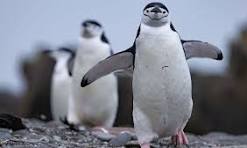Not all animals are telegenic, you know.
We rarely see a good film about anteaters, moles or wild boars. But penguins are always ready for their close-ups.
“They’re so much like people … very relatable,” said filmmaker Bertie Gregory, whose charming “Secrets of the Penguins” debuts from 8-11 p.m. Sunday (April 20) on the National Geographic Channel, then repeats on Earth Day (April 22).
In a way, penguins have the qualities of an ideal date: They’re cute and available.
“Most filmmakers are hidden behind bushes, shooting with a Zoom lens,” Gregory said. But penguins don’t mind company; at times, they’ll even visit the human and stare with curiosity.
They help fulfill a key goal for wildlife filmmaking: “If you can get people to fall in love with these animals and to have this deeper respect for nature, (people might) fight harder” for the environment, James Cameron said.
Cameron, 70, is best-known for directing the “Terminator” and “Avatar” movies and “Titanic.” In recent years, however, he’s also been busy producing epic documentaries. Three of them – elephants, octopuses and now penguins – are in the Earth Day line-ups of two National Geographic channels and Disney+.
Like the previous ones, “Secrets of the Penguins” has a global expanse, finding huge contrasts. We see:
— Adult penguins ranging from 4-feet-tall to 18 inches.
— Personalities that range from the serene (“the emperor penguin is quite calm,” Gregory said) to the hectic. “The gentoo is chaotic …. They’re always fighting and shouting.”
— Evolutionary adaptation. In the perilous Southern Ocean settings, gentoos have twins, hoping one will survive; in Antarctica, emperors always has one, which is all a pouch can shield.
— And setting. In the Namib desert during filming, the temperature was 90 above zero; in Antarctica, it was 54 below.
Yes, minus-54. With the wind reportedly at 120 miles an hour, the team’s safety chief ordered a retreat. “When he says go, we go,” Gregory said.
Their first hideout failed; “five of our eight tents ripped.” They retreated further, spending the next six days in two shipping containers.
For wildlife films, Gregory said, a typical shoot might be 4-6weeks. But his team was in Antarctica for double that … and a separate team stayed in Antarctica for 274 days. “That’s a real sacrifice, being away from their families that long.”
He also had two other shoots – one on Galapagos Island, near Ecuador, another in the Southern Ocean.
The latter let him witness the gentoos, zooming under his boat. They reportedly reach 22-mph.
“The fastest Olympic swimmer is about 5-mph,” Gregory said. “Sorry, Michael Phelps; eat their bubbles.”
We underestimate the penguins physically, he said. As they waddle on land, they look “clumsy, kind of goofy.” In the water, they accelerate quickly.
And on land, that waddling is efficient. Humans move two or three feet of leg with each step; the penguin needs only four inches.
Gregory was given research on what to expect. The mini-series shows penguins leap off a 50-foot cliff … and confront a giant sea lion … and scout birds, grabbng their leftover fish … and herd anchovies through narrow corridors that others can’t reach.
Most remarkable, perhaps, was a report that penguins would literally steal fish out of the bill of a pelican. That worked out neatly, he said. “The penguins had read the script, which doesn’t happen often. The question was how to get the right angle to show it.”
Other cameramen caught more behavior, from rockhoppers scaling a huge cliff to a citified penguin. Near Capetown, South Africa, he leaves the seaside, waddles through traffic and finds his wife and family in suburbia.
And he does it, of course, while being quite cute.
“Secrets of the …”
— Penguins, 8-11 p.m. Sunday, April 20 (premiere) and Tuesday, April 22; both National Geographic Channel and NatGeo Wild.
— Elephants, 1-5 p.m. Sunday, NGC; 4-8 p.m. Sunday, Wild; 4-8 p.m.; 4-8 p.m. April 22. NGC.
— Octopuse, 5-8 p.m. Sunday, NGC; 11:37 a.m. to 2:29 p.m. April 22, Wild; 1-4 p.m.April 22, NGC; 11 p.m. April 22 to 2 a.m., Wild.
